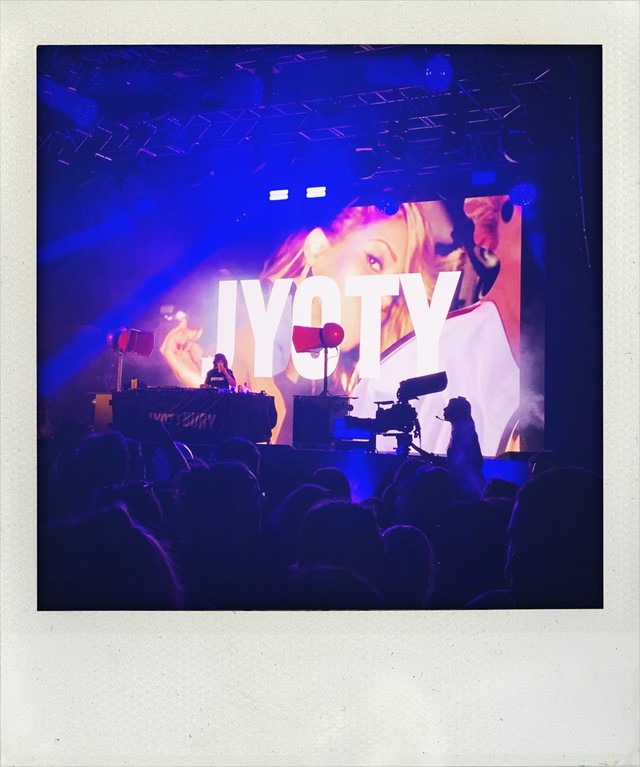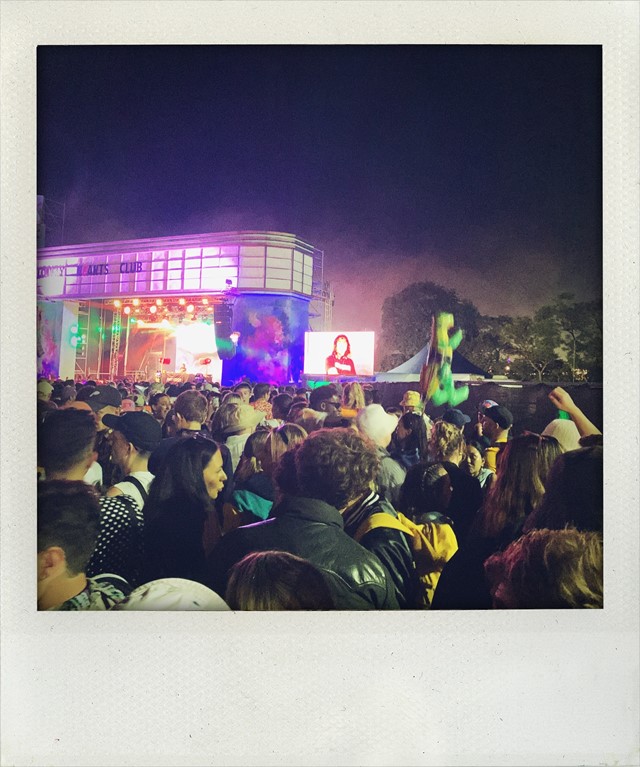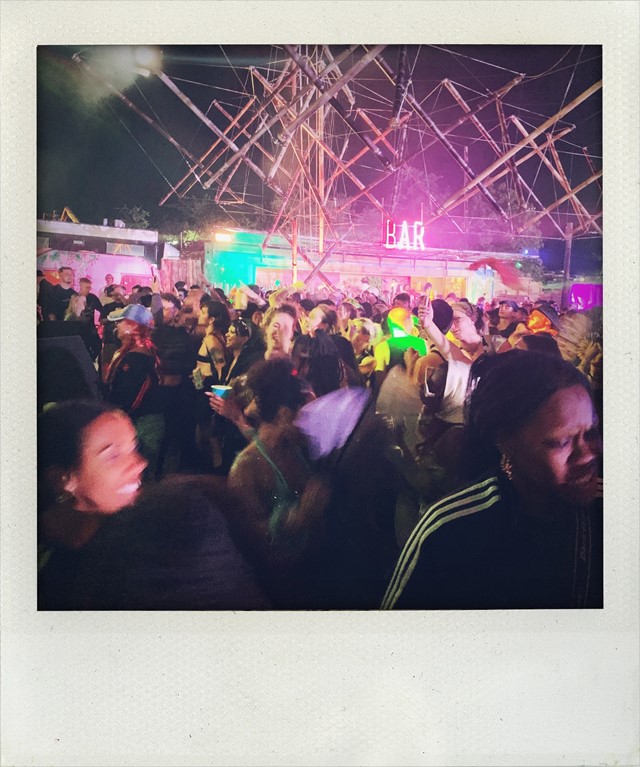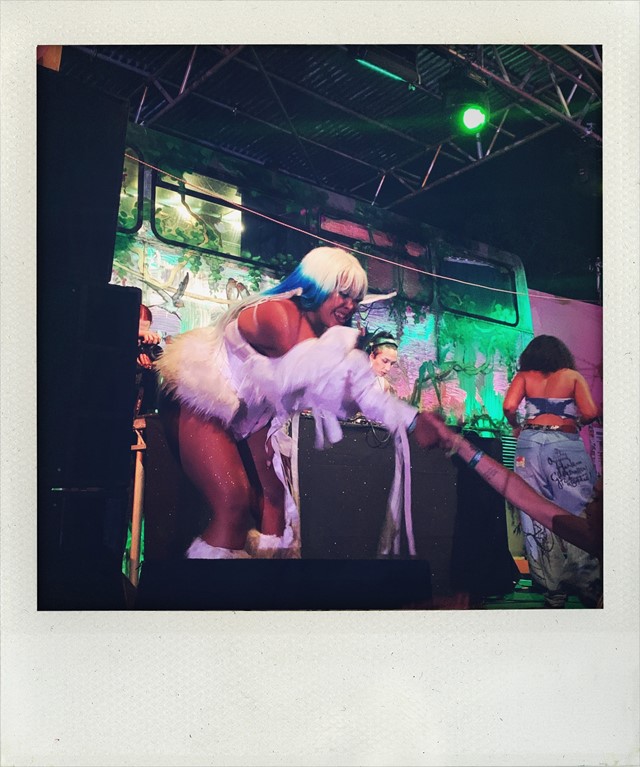Amid accusations of a “pale, male and stale” lineup, Kemi Alemoru found pockets of joy at the legendary music festival, as well as reasons for hope
After 162,000 steps, four nights in a row of walking home at sunrise to get at least three crucial hours of sleep, and trekking around a field to hear some of the world’s greatest living performers, Glastonbury has come and gone. Due to all of the above, I’ve only just managed to claw back my grasp on the English language to articulate the takeaway from this year’s musical marathon: that this country’s POC underground deserves a leg up.
You could have easily got a lot of signatures on a petition to legally rename Glastonbury “sausage fest” for 2023 after the lineup was first released. Once this year’s schedule was out, even Lana Del Rey weighed in on the conversation due to her outrage of being put on the Other Stage rather than the much-revered Pyramid, referring to the mainstage headliners as “pale, male and stale”.

Emily Eavis, daughter of Michael Eavis who founded the arts festival, blamed the debacle on a “pipeline problem”. That is to say that there is an industry-wide issue of nurturing people of colour, and artists of marginalised genders, and that more is needed to close the gap between the underground and those who have the honour of appearing in the largest font on the poster. It’s a fact that I find peculiar as a cultural commentator, well aware of talent that is forever referred to as ‘up and coming’, even if they have put in years of consistently acclaimed work and have built a strong community and reputation.
Speaking to women of colour at the festival about the representation on the lineup elicited similar responses. Mona Soussi, a Shelter volunteer at the festival, was quite blunt. “It felt sad that the festival Jay-Z headlined back in 2008, is yet to headline a woman rapper over 15 years on,” she said. “Little Simz, Nicki Minaj, Doja Cat, Megan thee Stallion, and even as a Barb I would say Cardi B, came to mind initially as names that could take that spot.” Instead, her highlight was Lady Shaka in Shangri-La who mixed Indigenous sounds into her set. “It felt really powerful,” she adds.
But there were so many glimmers of hope and demonstrations of progress. Elton John had probably seen all of the discourse surrounding the Pyramid’s diversity problem this year. During what had been announced as his final live performance, the musical legend chose to diversify the mainstage and affirm rising artists of colour, knowing almost everyone on Worthy Farm would come to watch the historic moment. He shared his spotlight with Jacob Lusk, the frighteningly moving Black lead vocalist of Gabriels, hotly-tipped as a band to watch, and one of his former collaborators, east Asian electro-pop star Rina Sawayama, whose albums have begun edging into top UK charts. Another act that also got a nod from Elton was the Nova Twins, who he hailed as a highlight of the festival in a TV interview with Clara Amfo. “That was the most mindblowing thing. We all got goosebumps,” the band’s Jamaican-Australian bass guitarist and backing vocalist, Georgia South said.
The independent rock duo that comprises of South and her childhood best friend Amy Love, the Iranian-Nigerian lead vocalist, have been making music since 2014. And they’ve been vocal about the industry’s inability to take chances on POC artists to push them into the spotlight. Last year, the MOBOs added an alternative music category in response to a letter they had written calling for the award ceremony to support Black artists and show them they can be whatever they want to be. The pair also bring smaller bands from minority backgrounds on tour with them to develop their own supportive eco-system. “If you don't have that kind of major label, money, infrastructure, you need champions,” Love said. Seeing the other out-of-the-box women of colour on the lineup was a hint at the health of the scene. “Seeing Sudan Archives and Shygirl, strong women slaying it, was really brilliant. They were some of the best sets you saw all weekend,” added Love with a laugh.

The pair, all in all, had a really positive experience at Glastonbury, noting that the women of colour in the alternative music scene are gradually getting more recognition. They were also both impressed that an artist at Elton’s level recognised how to wield his power and influence to uplift other people trying to break from the underground to the same heights he was due to experience on that day. “He called us to the Pyramid Stage just before his show and told us we were amazing and gave us encouragement,” says South. After her performance with Elton, Rina Sawayama experienced a sharp rise in streams as a result, illustrating how visibility at the festival could be the driver that moves artists of colour towards a top billing in their own right.
While the initial release of the lineup evoked debate as the headliners were mostly white and male, if you accepted that the Pyramid Stage was not your central focus this year you were free to discover new and experimental artists. For nocturnal partygoers who stretch their experience of the festival, you see a side of it that you can’t watch on television like the stages at Silver Hayes or Shangri-La and Block 9 in the South East Corner and it’s so good the daytime begins to matter less and less.
There’s a specific art to curating the night-time headliners at the festival because you want to see someone with star power, who also fuels you with enough energy to begin your pilgrimage to the South East Corner which includes potentially vibe-altering people traffic diversions that mean you’re packed tightly in slow-moving wide-eyed crowds, enduring clashing BPMs before you reach the next pivotal act of your night. If the last person you saw bored you to tears, then it ruins the flow of your evening.
Almass Badat, who curated a takeover of Lost in Shangri-La for Dialled In agrees that the area is the main character. “A festival to the scale of Glastonbury is so multifaceted, so finding your tribe, people who share similar values is key. In our experience, working with Shangri-La, which is a specific part of Glastonbury that originates from the Traveller community, is a uniquely radical experience to the rest of the festival.” Programming in the epicentre of debauchery, the South East Corner, is more aligned with the ethos of DIY music collectives. She explains: “We had full creative reign, meaning we had two hours to fill how we wanted. We chose to invite ten-plus DJs on the decks and Bolly Illusion to perform, and we had no music policy.”

Another festival attendee, Fatima, for whom it was the first time at the festival, said her mind became completely focused on the Silver Hayes area. “There was so much joy and love in that area and so many good DJs: Sherelle, Lil Silva, Nooriyah ... I spent the majority of my free time dancing at the Lonely Hearts stage and The Levels and everyone around me was so welcoming, happy and having a blast. [It was] definitely the area to be at night.”
Fatima, who is 25, described the choice of greying headliners as “baffling” and “irrelevant” to contemporary music lovers and found, as a first-timer, the judgement of not going to see Guns and Roses was “a bit alienating”. She added: “I think Glastonbury given its status has a duty to search for good diverse talent because it is out there and so [the pipeline] statement feels a bit lazy, when you book good talent people will inevitably have a good time and go again and again to any further shows they might have. I think Emily [Eavis] is perhaps underestimating both the talent and the festival itself.”
There are definitely signs of the festival making strides in the right direction. In what was her first time playing Glastonbury, Jyoty curated the Lonely Hearts Stage on Thursday, taking the buoyant crowd from golden hour into the first real night of dancing featuring appearances from SBTRKT, Charisse C, Jael and Lil Silva. The sound of Girls Can’t DJ entertained crowds at the festival’s new neon-lit stage, The Levels, in Silver Hayes. Described as both a talent incubator and a platform, their mission is to get more women, especially women of colour, onto lineups. And I noticed that they had shifted Shygirl from a late-night ICON stage slot where she was last year – a stone’s throw away from NYC Downlow which was definitely an incredible choice for her own chaotic brand of smutty dance music – to an early evening billing on the Park stage which was broadcast on television. While I wished she was on later, it feels like a promotion that you can at least watch her back on iPlayer.
Of course, DJs here won’t get as much recognition or pay as, for example, Fred Again who got to play both Temple in the South East Corner, and a sunset set on the televised Other stage. “I’d like room for more South Asian artists to host and perform on main or larger stages because our art operates on a global standard of quality. There is always room for more inclusivity from headline to grassroots,” says Badat.

Reeling off names of collectives, some of whom were on the lineup, Badat describes a cohort on the ascent that people should follow after the festival. “Dialled In, Lucide, Free Yard, Cousins, Pulotu Underworld, Touchin Bass, Shindig Nights, Misery Party, Prestige Pak, Arthi Hard, Vibrate Worldwide, No Nazar, Motherland by Dibs, Jawani at the Standard, Pxssy Palace, Dankie Sounds, Mpaghara, Glowed Up, Karen Nyame, Hagan, Girls Don’t Sync, Club Yeke, Trippin, Deejay Samrai in Manchester, PNGA,” she lists. “This is just scratching the surface!”
“Broadcasters should realise that the heart of living, breathing music culture is on the ground and in the tents, after parties, communities and candid moments,” Badat explains. “The underground is where the magic is, and the main stage is where spotlights can be shone. True art isn’t about numbers, but rather craftsmanship, the message, feeling, expression.” And therein lies the fix for Eavis’ pipeline issue. “Put money into nurturing and growing talent. Take more risks on artists, and realise that in 2023, audience listening habits are global.”
Without doubt, my favourite night of the festival took place at Nomad as Pxssy Palace took over. We danced until 6am to the sounds of Nadine Noor, Mya Mehmi, Ryan Lovell, Anairin Kaines, Jordss and Shivum Dharma. It was the most consistent vibe in Shangri-La that evening which, let’s say just say it, is criminally obsessed with ear-splitting drum and bass. Pxssy Palace’s little-known dancers and performers for this QTPOC takeover, and also for the Trans Pride events for the rest of the festival, were more exhilarating than anything that happened on the mainstage (bar Lil Nas X, but again that is QTPOC saving the day).
Each year I find these joyous pockets to be the standout moments. These nods, I hope, are a turning point for musicians and collectives that exist on the fringes who will hopefully move higher and higher up the lineups in the coming years.
